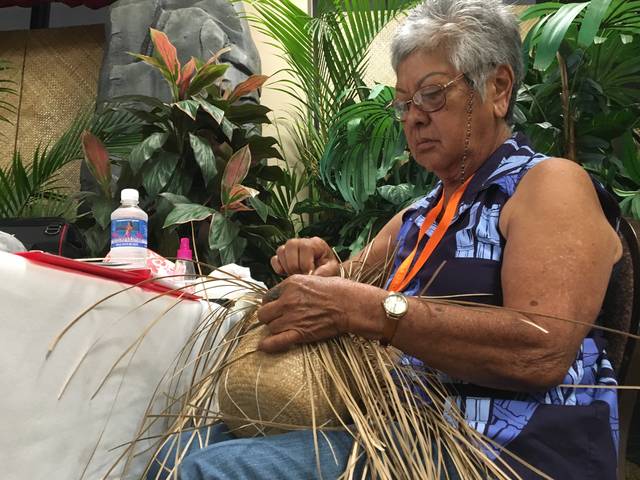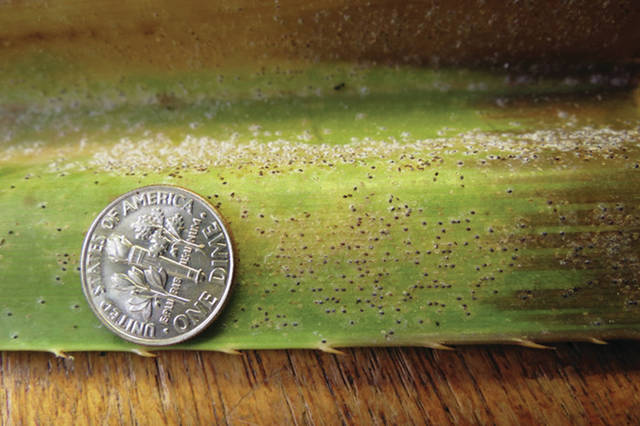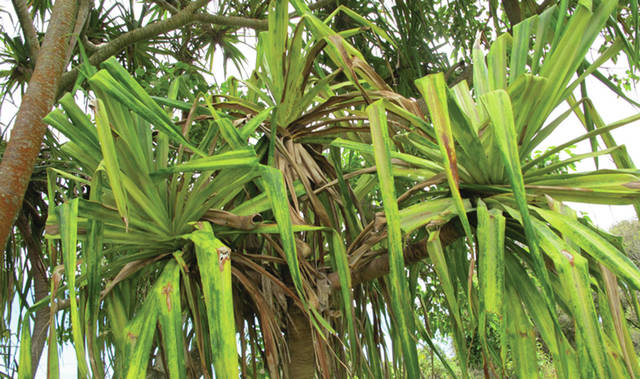State raising awareness of hala scale + VIDEO
KAILUA-KONA — After her hala grove was overcome with an infestation of pests two years ago, Molokai kumu Lola Spencer’s weaving family came to her aid.
The grove of about a dozen hala trees, some taller than houses, had become infested with hala scale, an invasive species that severely damages hala trees, causing discoloration or stunted growth in leaves and, in some cases, premature death of the tree, according to a Hawaii Department of Agriculture fact sheet.
The weaver of at least 25 years said that while she could still weave with the leaves, she was concerned about making crafts for others with poor-quality material.
“If I made a hat then somebody bought it and then it disintegrated, I didn’t want that,” she said. “I wanted to be sure that the lauhala was good.”
Fortunately, she said, fellow weavers have come to her aid, providing her with leaves from areas free of scales, allowing her to keep weaving.
“It goes beyond appreciation; it’s such a weaving family,” she said. “It’s a family just giving you and not expecting anything back.”
Spencer said she’d be distraught if it weren’t for that network of support.
“I would be crying,” she said. “I mean, I would be really distraught, because I love to weave.”
Spencer was one of many at the 22nd annual Ka Ulu Lauhala O Kona Conference at King Kamehameha’s Kona Beach Hotel.
And among the kumu and haumana (students or apprentices) were also representatives from the Hawaii Department of Agriculture, determined to raise awareness of hala scale and ongoing efforts to fight the pest and preserve the art of lauhala weaving.
Hala scale was first detected in Maui in 1995, said Juliana Yalemar, an entomologist with the Biocontrol Section. But the insect didn’t start moving interisland to Molokai and then Oahu until the 2000s, she said, prompting wider concern.
“That’s when we started getting worried about it,” she said.
The insects’ establishment in Maui is directly hurting local lauhala practices, Yalemar said. When the scale attacks the plants, she said, the leaves are stunted, making them unideal for weaving. The insects also cause yellowing discoloration.
“You don’t want to use something like this to weave,” said Derek Arakaki, noxious weed specialist under the plant pest control branch of the Department of Agriculture. “It’s very ugly.”
And weavers can freeze the leaves to kill off the bugs, but it doesn’t undo the damage already done.
Today, the insect is known to be on Maui and Molokai, with “very limited infestation on Oahu.”
Hala scale isn’t on the Big Island, nor is it on Kauai, and the department is trying to keep it that way.
Yalemar and Arakaki, said they were trying to raise awareness among weavers at the conference.
“From what we’re finding out, even some of the weavers are not aware of it,” said Yalemar, “so, yeah, we want to reach as many people as possible … We want to start with the weavers because they’re the ones that are associated with the plants.”
And the message is being well-received at the conference.
“They appreciate the information,” Arakaki said. “And I think a lot of them are concerned that it would spread to their island.”
The Department of Agriculture is still working toward finding a biocontrol agent that can help them combat the hala scale.
Yalemar said an exploratory entomologist has been doing research in places including Thailand and Malaysia looking for some sort of solution.
“So far,” she said, “we haven’t been successful in raising whatever they brought back. Usually, it will just die off, so we’re still looking.”
For now, she added, the department is specifically looking at other insects that could help the fight against hala scale, but she said they’re looking at everything.
Arakaki said any proposed solution has to be extensively vetted.
“It’s not like just bringing something back and releasing it,” he said. “It has to go through testing, make sure it doesn’t affect the wrong plants or the wrong insect.
“There’s a lot of testing that goes on,” he added. “It takes years.”
Weavers and others, meanwhile can help the department by keeping hala scale from spreading.
That includes not moving infested plants or even moving plants from infested areas to areas hala scale hasn’t yet been detected.
Furthermore, the department representatives said the spread of hala scale can be mitigated by showering or changing clothes after spending time in infested areas. Especially because the juvenile insects are too small to see without special equipment and can hitch a ride on clothes back to areas where they haven’t already established a population.
Even simple awareness can help stem the spread of the pest.
“Tell their neighbors to be on the lookout and as soon as they find it … they should call Department of Ag so we can do something right away,” Yalemar said.
Arakaki said that’s especially the case if the pest is found in places where it isn’t already known to occur.
“The public’s help,” he added, “that’s the only way we can prevent it from spreading.”
And for dedicated kumu like Spencer, there’s no time to wait.
“Don’t let it be like the ohia,” she said, referring to rapid ohia death. “That was too long. This one is getting to be too long.”





